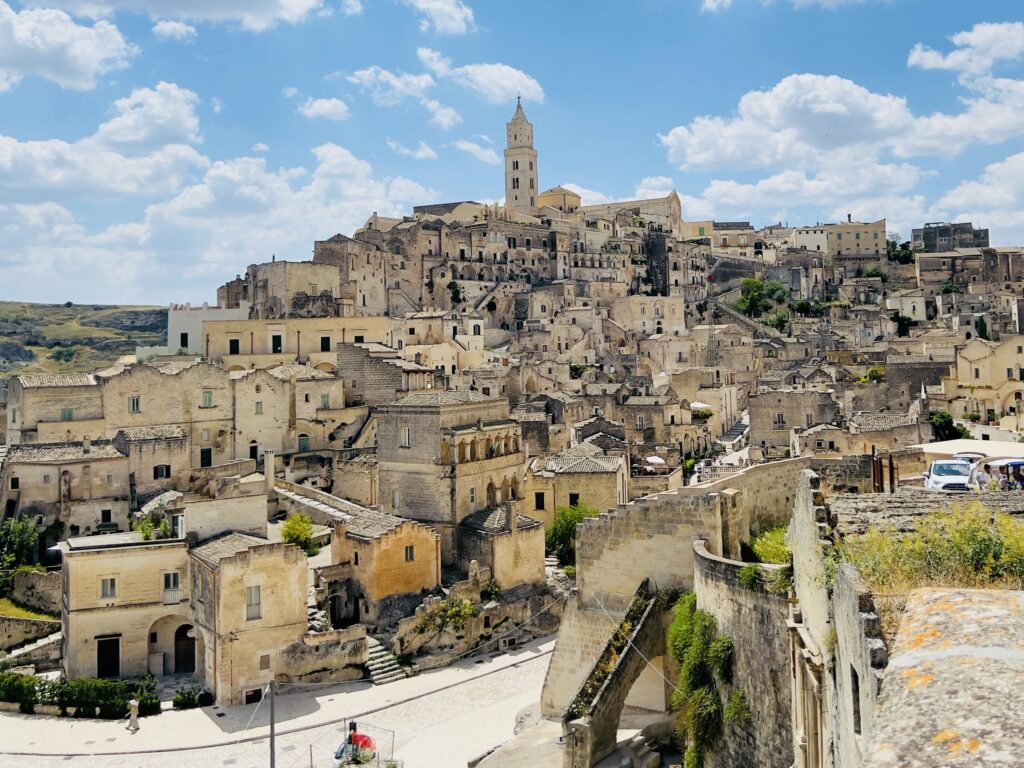
Nestled in the southern Italian region of Basilicata, the ancient city of Matera was once known as “the shame of Italy.” Residents lived in cave dwellings, or “sassi,” without electricity, running water, or basic sanitation. It wasn’t until the 1950s that the Italian government evicted the inhabitants and forced them to move into modern housing. Today, Matera has undergone a remarkable transformation, becoming a UNESCO World Heritage Site and a destination that draws visitors from around the world.
Contents
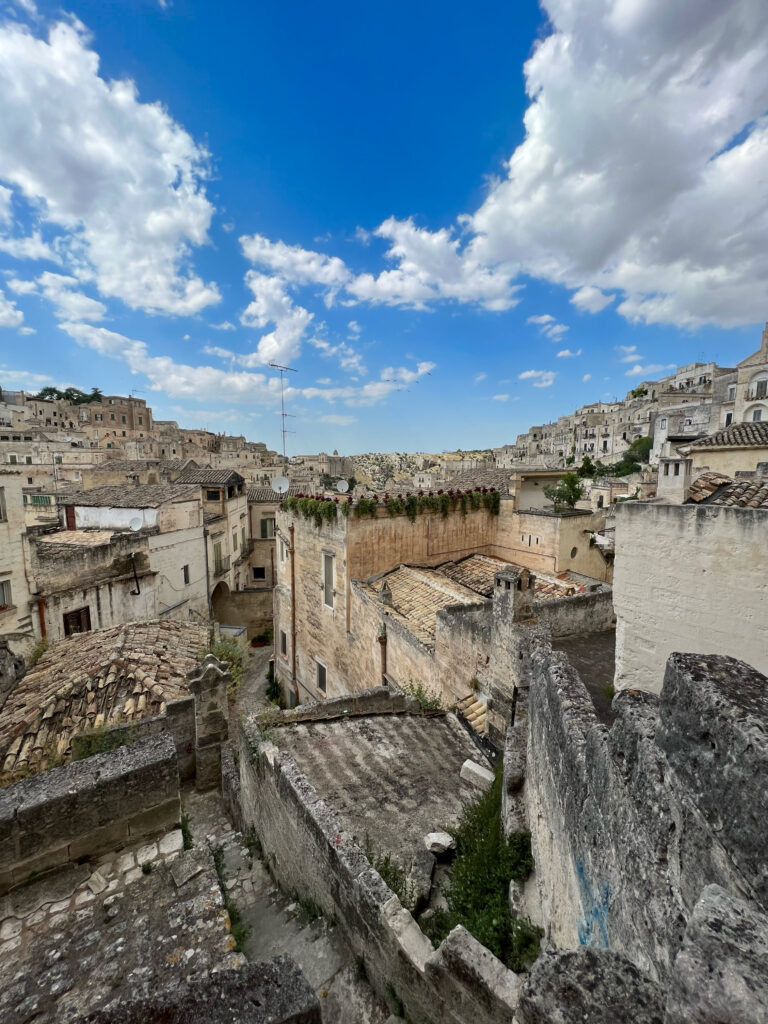
Matera is believed to be one of the oldest continuously inhabited cities in the world, with evidence of human settlements dating back to the Paleolithic era. Its unique landscape, known as the “Sassi,” a complex of ancient cave dwellings carved into the rock, have been designated a UNESCO World Heritage Site and offer visitors a glimpse into an ancient way of life.
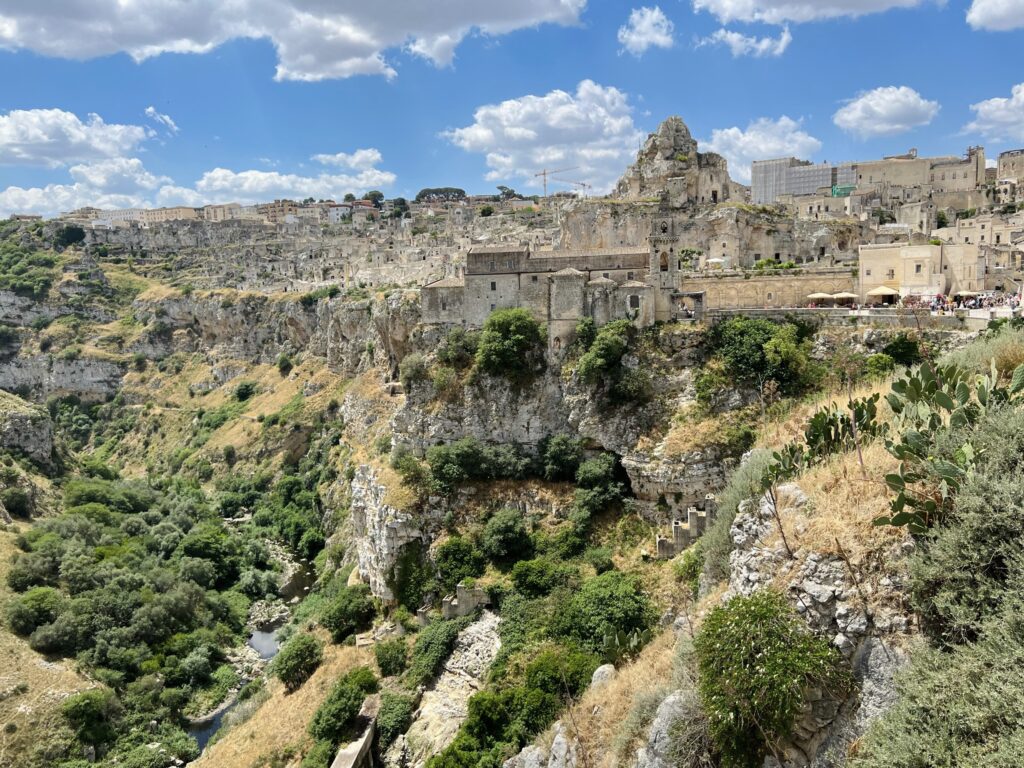
From Caves | “Christ Stopped at Eboli”
“Christ Stopped at Eboli”, a memoir by Carlo Levi published in 1945, caused a sensation. The book narrates the author’s exile in southern Italy during the fascist regime, a powerful testimony of poverty and social injustice in the area of Basilicata and the city of Matera. Levi describes the dire living conditions of the peasants in the region, isolated and marginalised from the rest of Italy. The title was taken from a local saying saying: that Christ never made it past Eboli, suggesting that the region was not only forsaken by God but also abandoned by the rest of the country.
He describes how his sister described Matera to him when she visited in 1936. A doctor, she had never met with poverty like this before, nor illnesses. Blindness caused by trachoma and what she took to be black fever, a disease usually confined to Africa. Some caves had no proper entrance. They were merely a hole in the ground with a trapdoor and ladder. Children lay on filthy rags, their teeth chattering from fever, sharing their dens with dogs, sheep, goats and pigs:
“I saw children with the faces of wizened old men, their bodies reduced by starvation almost to skeletons, their heads crawling with lice and covered with scabs. Most of them had enormous, dilated stomachs, and faces yellow and worn with malaria”.
The book had a profound impact on the national and international perception of Matera and Basilicata, as it exposed the social and economic inequalities that existed in the area. The book also raised awareness about the primitive living conditions in the Sassi, the ancient cave dwellings in Matera that were inhabited by families in poverty.
The publication of “Christ Stopped at Eboli” led to a wave of cultural and social reforms in Italy. It sparked a national debate on the living conditions of the southern regions, which resulted in the establishment of the Cassa per il Mezzogiorno, a government agency that aimed to develop the impoverished south.
In Matera the impact of Levi’s book was significant. The city was declared a national shame, and the government implemented a plan to evacuate the Sassi and relocate the inhabitants to modern housing. The conditions in which they lived were deemed unfit for human habitation, and the government feared an outbreak of disease. Residents were given little notice, and many were forced to leave behind their homes and possessions. It destroyed the traditional way of life of the Sassi dwellers and their cultural heritage.
It wasn’t until the 1980s that efforts began to restore the abandoned sassi, and Matera started to gain recognition as a unique and important historical site.

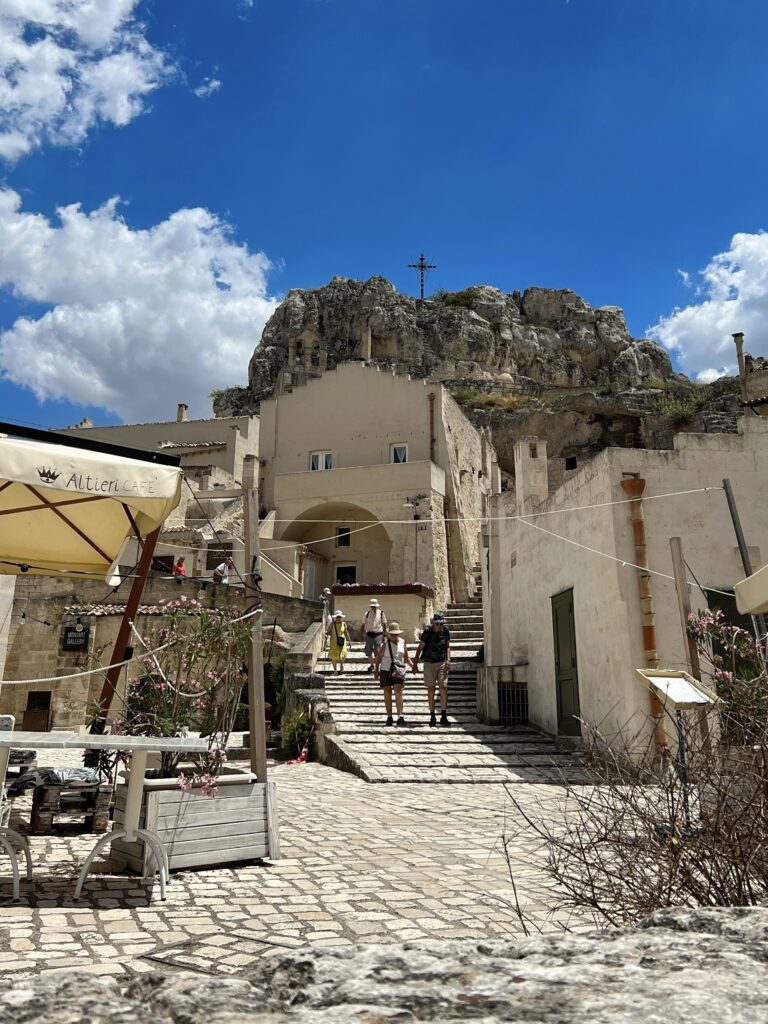
To Culture | UNESCO and European Capital of Culture
In 1993 the Sassi di Matera were declared a UNESCO World Heritage Site. The Sassi were restored and turned into a cultural destination. Today, the city attracts tourists from all over the world, who come to see the ancient cave dwellings and experience the rich cultural heritage of the region.
Becoming a UNESCO World Heritage Site in 1993 was a turning point for Matera. The recognition brought international attention to the city’s Sassi. The designation helped Matera preserve and restore its historic center, which had been neglected for decades. It also made Matera a cultural destination for tourists, attracting visitors from all over the world.
European Capital of Culture
In 2019, Matera was named the European Capital of Culture, a title it shared with Plovdiv, Bulgaria. This recognition further enhanced Matera’s cultural reputation and spurred the city’s cultural and artistic development. The designation brought investment to the city’s cultural sector, creating new job opportunities and revitalising the city’s economy.
Throughout the year, the city played host to a variety of events, including music festivals, art exhibitions, and theater performances, all showcasing the best of Matera’s artistic and cultural offerings.
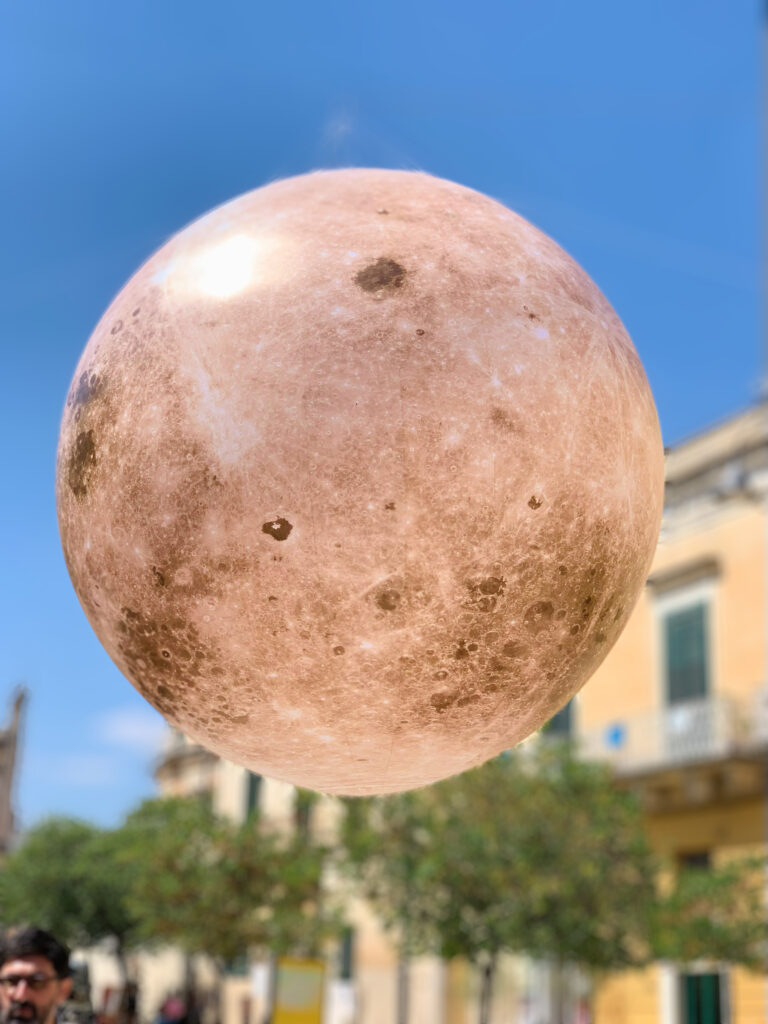
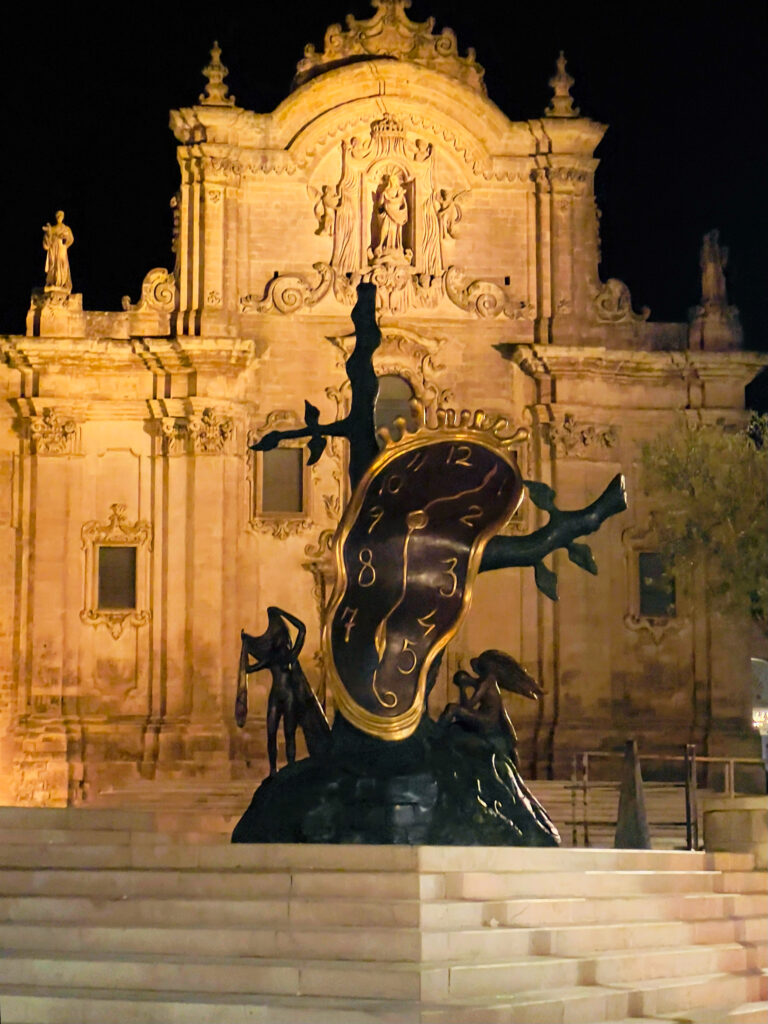
James Bond No Time To Die
Matera has even made its way onto the big screen, most notably featuring in the latest James Bond film, “No Time to Die.” The city’s breathtaking views serve as the backdrop for some of the film’s most iconic scenes, including a high-speed chase through the Sassi. For film buffs, visiting Matera is a chance to step into the world of James Bond and experience the city’s beauty first hand.
Although this may be the first appearance for Matera in the Bond collection, international movie buffs will be familiar with its rock dwellings built into the hills and arid otherworldly surroundings. Pier Paolo Pasolini set the story of Jesus’s life here in the 1964 classic “The Gospel According to St Matthew”. The 2003 Italian crime mystery thriller “Io non ho paura” (I’m not Scared), directed by Gabriele Salvatores, was shot nearby. And Mel Gibson’s controversial 2004 biblical drama “The Passion of Christ” used numerous other locations.
Matera’s appearance in the James Bond film “No Time To Die” was definitely another milestone in the city’s cultural history.

Getting Around
Matera is a joy to explore on foot. Its geography makes it relatively easy to get your bearings on the vertical. The trick is navigating the winding alleys and ways and managing the levels as you descend. A wrong turn can take you in a different direction and, although you’ll still come to Via Madonna delle Virtù, you might end up with an unexpected longer walk. Good luck with sat nav – it confuses the heck out of us!
This route covers many of the major sites and attractions in the Sassi of Matera and can be completed in about 2-3 hours depending on how much time you spend at each location. Note that the streets in the Sassi can be steep and uneven, so be sure to wear comfortable shoes. Bring water and sunscreen.
Keep in mind 4 key locations, for four parts of the journey. The rest you can work out between and around them. You don’t need to start at Piazza Vittorio Veneto. We have suggested the main square because of its proximity to the train station (and parking areas). You can start anywhere, and in either direction. If you are staying in the Sassi it might make sense to start at Piazza San Pietro Caveoso and walk up.
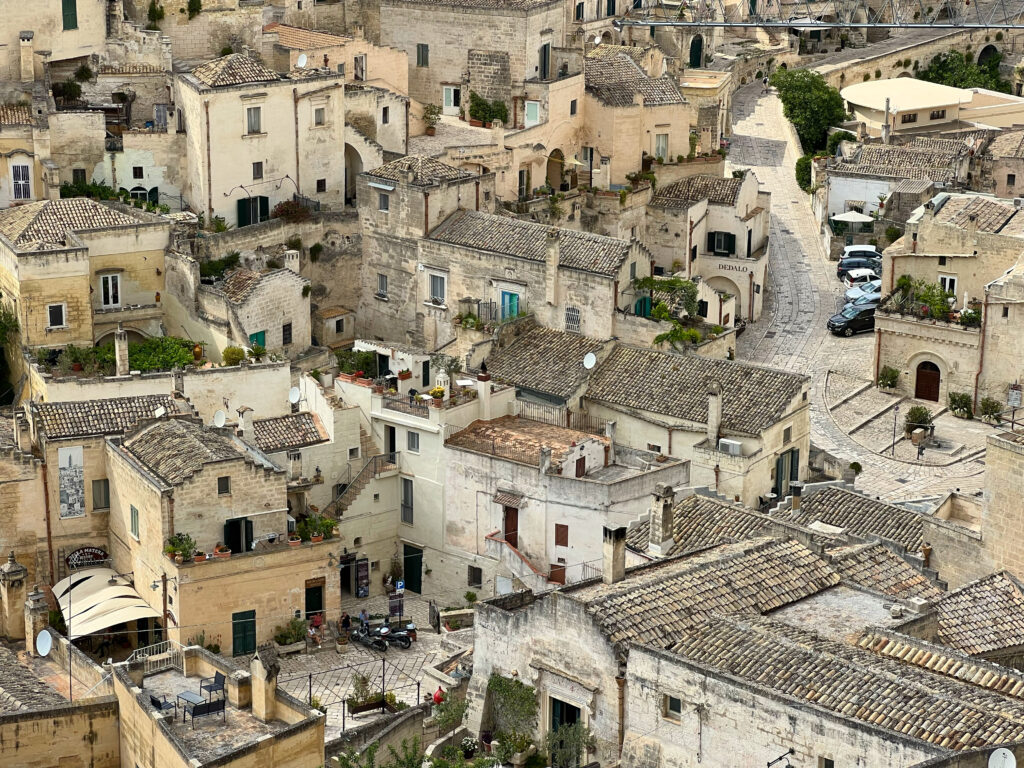
Our suggestion isn’t intended to be prescriptive, rather to give you a structure to base your walking around. The green lines on the screenshot below indicate the general direction, rather than the route, and connect the landmarks. The actual route between the locations meanders somewhat, all part of the fun.
- Piazza Vittorio Veneto (1) to the Piazza Duomo (2) for the Basilica (gentle climb, steeper towards the Duomo).
- Piazza Duomo (2) to Piazza San Pietro Caveoso (3) (incline down).
- Piazza San Pietro Caveoso (3) to Piazza Pascoli (4) (uphill).
- Piazza Pascoli (4) back to Piazza Vittorio Veneto (1) (level-ish).
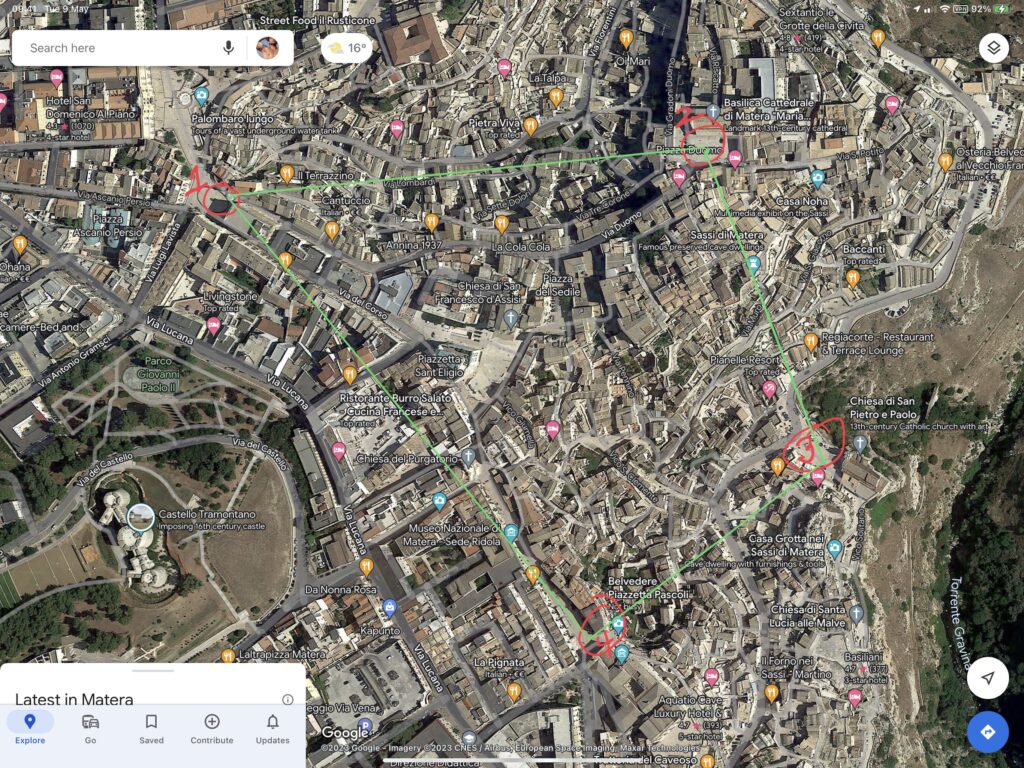
- Start at Piazza Vittorio Veneto (1). This is the main square in Matera and is a good starting point for your walk. At the top end of the piazza is “I Tre Archi” which has a wonderful panoramic view over the sassi. The Mondadori Bookstore is a nice visit, with some tasteful Matera themed gifts (notebooks, cards, calendars). You can pop in before or after refreshments at Bar Caffè Tripoli which has a nice seating area outside at the side of the piazza. For a cheap and cheerful lunch we’ve eaten pasta at Pasteggiando 1 – The Way Of Pasta (choose your pasta and separately your sauce). For an enjoyable dinner on the piazza we ate at La Finestra sui Sassi – Kappador (and thoroughly recommend the strascinate con salsiccia pezzente, mollica di Pane di Matera e peperone crusco, strascinate pasta with peasant sausage, breadcrumbs and sun dried crusci peppers). Nearby (between the piazza and the main train station) you will also find the mercato storico di Matera centrale food market well worth a visit.
- At the Post Office (Poste Italiane), before coming onto Piazza San Francesco, take a left to connect with Via delle Beccherie (continuing up onto the via Duomo to the Basilica Cattedrale di Matera (2)). Via delle Beccherie is one of the oldest in the Sassi and is lined with traditional stone houses and shops. You will pass by the Conservatory where you might here some classes taking place, either singing or musicians. If so, maybe take a moment to listen. You can have a coffee or refreshments at one of the bars on the Piazza del Sedile and soak up the atmosphere. Further along we sometimes stop off at the Monkey Drink House
- Continue up the via Duomo to Piazza Duomo and the Basilica Cattedrale di Matera.
- From here, depending on your energy levels and/or the heat you can opt for a long or short walk around the Via Madonna delle Virtù ending at Piazza San Pietro Caveoso (3). Either way it offers stunning panoramic views of the city and over the gravina. For the long walk head from the Duomo in this direction. For a shorter walk head in the direction of Piazza San Pietro Caveoso. Somewhere in between, head towards Casa Noha where you will find a multimedia exhibition in a cave dwelling. Be prepared to meander!
- Piazza San Pietro Caveoso: This square is located in the Caveoso district of the Sassi and features several historic buildings and churches, including the Chiesa di San Pietro Caveoso. From here you can enjoy the views, stop for a coffee or refreshments. Kiev Ristorante has nice terrace space on the square. We’ve enjoyed shopping for souvenirs at Peperoncino and had lunch at Altieri Cafè, for inexpensive local dishes including (the unfortunately named) crapiata, a plain bean stew made a little more interesting with some crushed cruschi that we sprinkled on top. For dinner we have enjoyed repeat visits to Ristorante Francesca for finer dining.
- Before heading up Via Bruno Buozzi towards Piazzetta Pascoli stop off for Chiesa Rupestre di Santa Maria di Idris built into the rocky hilltop, with its frescoes. As you continue up along Via Buozzi there are many places to eat or drink along the way. This is also a good place to go off the track and head into the heart of the Sassi, and walk around. For example head off Via Bruno Buozzi along Via San Pietro Caveoso in this direction. Or head up Ponte San Pietro Caveoso in this direction. In either case the aim is to connect with the route again along Via Domenico Ridola somewhere around here! But be sure to head back to Piazza Pascoli (4) for the panoramic view at Belvedere Piazzetta Pascoli. A great spot to take a break and enjoy the scenery and take some photos.
- If you have stuck to Via Bruno Buozzi to take you up, it connects with Via Casalnuovo. Turn right towards Charlie’s Speakeasy and continue along Via Casalnuovo towards the steps by Area 8 to take you up to the Piazza and onto Via Ridola. Look out on the left for a strange little house that looks like a creepy old museum, but as far as we can tell is still lived in. We haven’t been to the Speakeasy but we have had a fun late night out at Area 8.
- From Piazzetta Pascoli head along Via Domenico Ridola towards Piazza San Francesco where you find the Chiesa di San Francesco with Baroque architecture and artworks. Via Ridola is lined with shops, restaurants, and bars, and is a great place to stop for a coffee or snack. Not to be missed is the gelateria: I Vizi degli Angeli – Gelateria Artigianale. Even better if the lavender ice-cream is in season. If not don’t worry, the flavours are delicious and the ice-lollies are top. Especially the Aperol Spritz flavoured lolly.
- You will pass by the Chiesa del Purgatorio. Just before the church up along Via Alessandro Volta is Ocio Sandwich Room, perfect for a morning coffee and pastry, a light panino lunch or evening aperitivo. We had a fun night out here too.
- Continue along Via Ridola until you reach the Chiesa di San Francesco. Then head back to Piazza Vittorio Veneto.

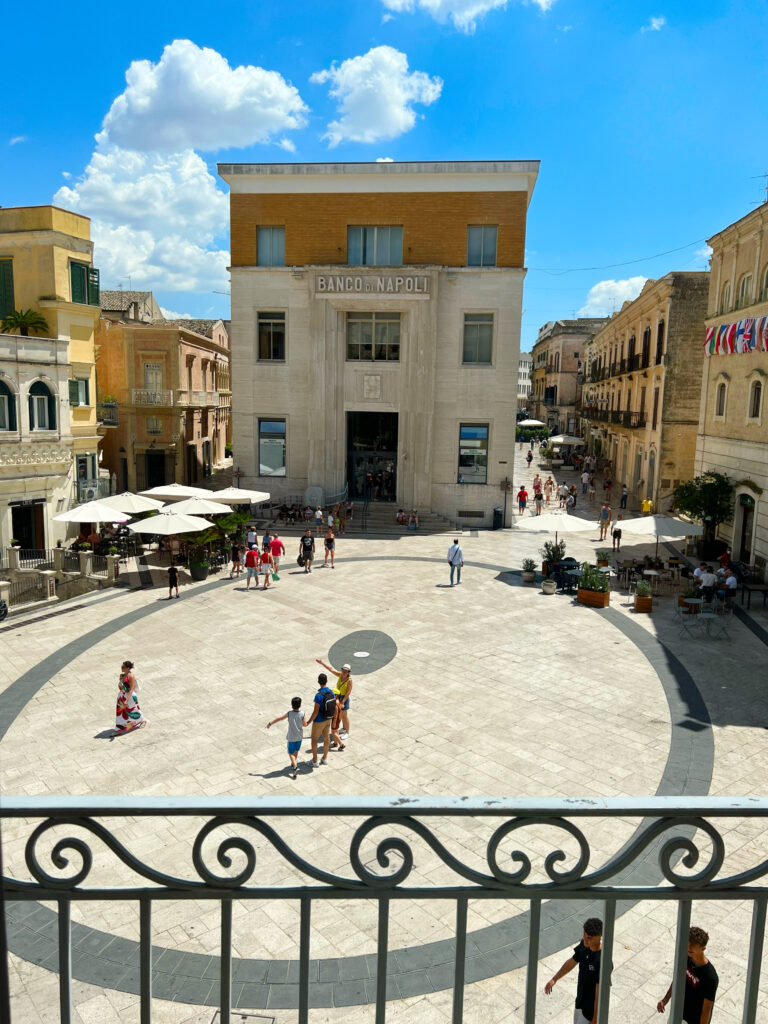
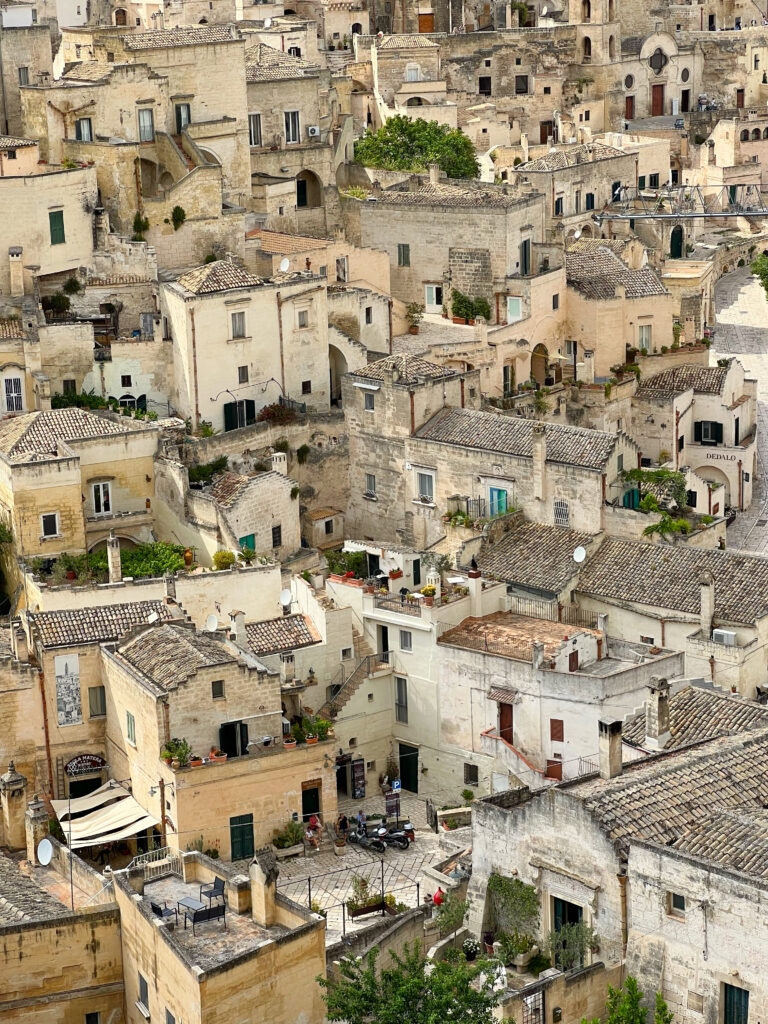
Guided Tours
Matera City Tour offer a guided walking tour. They also offer a sightseeing bus tour which we were up for, although we hadn’t booked and we missed the window of opportunity. At €15 for 90 minutes it looked very good value, and certainly convenient and easy. We recommend booking as the bus is relatively small and when we visited there were only a few circuits daily. It is not a hop-on hop-off tour, although we did see it stop at Piazza San Pietro Caveoso.
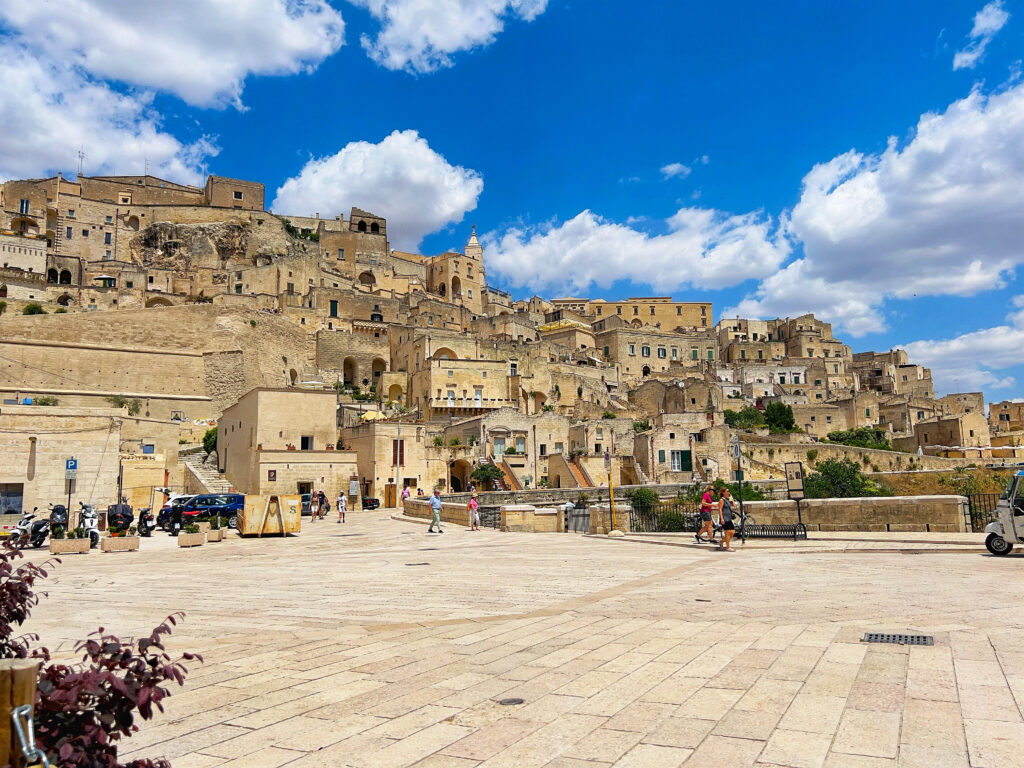
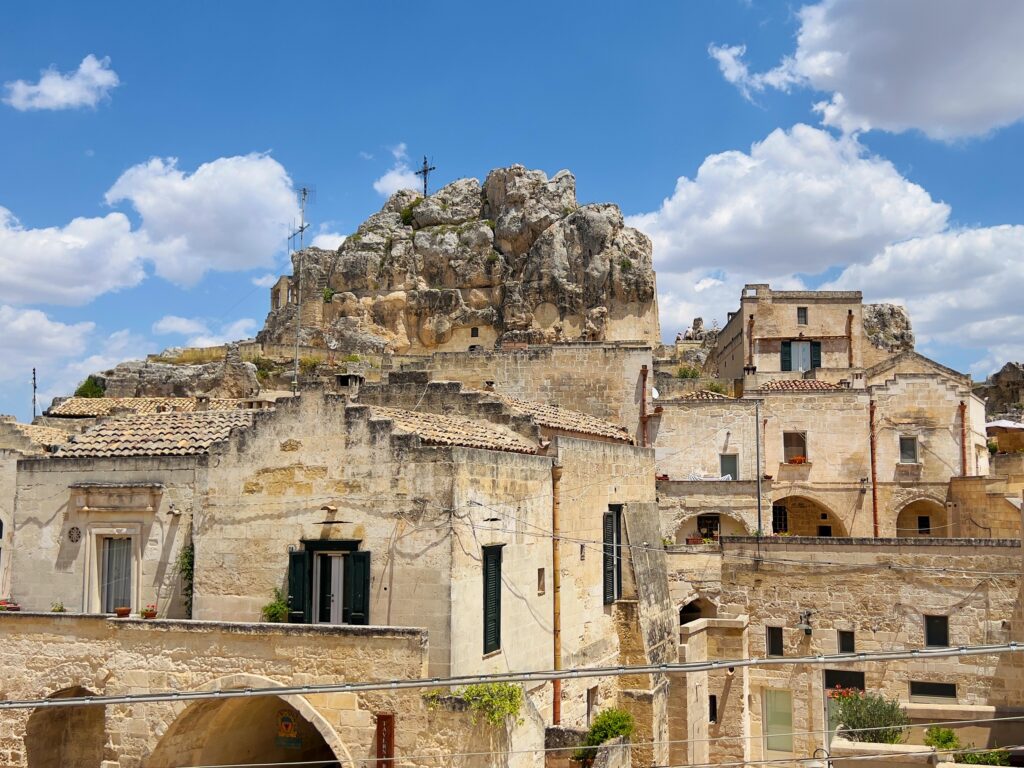
Five Dishes to Try in Matera
Local ingredients such as wheat, beans, and wild greens feature prominently in Matera’s dishes, which are simple yet flavorful. The region is also renowned for its wine production, with several local wineries offering tastings and tours. The region’s wine, Aglianico del Vulture, is made from the Aglianico grape and is renowned for its full-bodied flavor and tannins.
Pignata
A hearty stew made with meat, potatoes, onions, and tomatoes, cooked in a clay pot over an open fire.
The Pignata takes its name from the earthenware “jug” in which the sheep is cooked. The meat, first blanched in boiling water to melt off excess fat, is put into the jug together with pieces of pecorino and sausage with vegetables, aromatic herbs and wild chicory. Once the jug is filled, the Pignata is sealed with the bread dough and baked for several hours, traditionally at the side of the open kitchen fire. The stew is served hot on the plates accompanied with fresh bread.
Cialledda
A salad made with stale bread, tomatoes, onions, and cucumbers, dressed with olive oil and vinegar.
Cialledda is a bread-based dishes found on most restaurant menus all year round, often with polpette – bread dumplings or meatballs, the meatballs – cooked in tomato sauce. The summer version uses up stale bread, chopped, soaked and kneaded by hand with tomatoes, adding seasonable vegetables, onions and olives all seasoned with extra virgin olive oil and oregano. In winter the bread is soaked in hot water. Seasonal vegetables and sometimes a poached egg are placed inside.
Fave and cicorielle
A very simple dish; broad bean purée (made from dried fava beans), with braised chicory. Usually made with foraged wild cicorielle, the bitter vegetables enhance the sweet taste of the beans. The two flavours are enhanced by the fruitiness of local extra virgin olive oil generously drizzled on top.
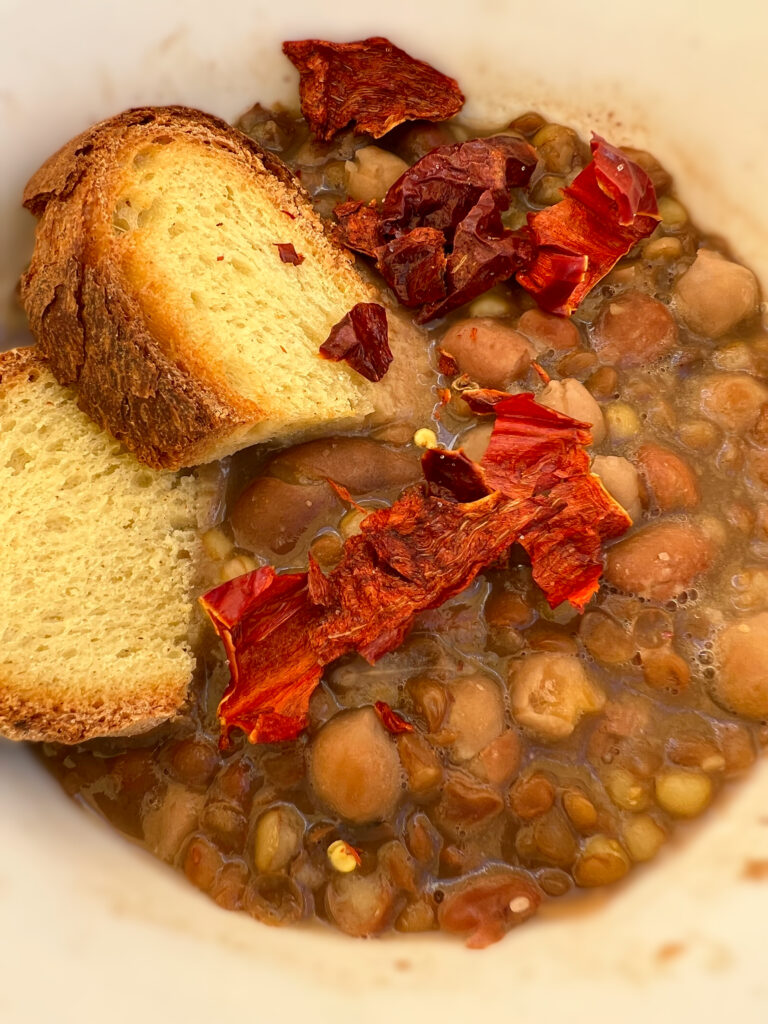
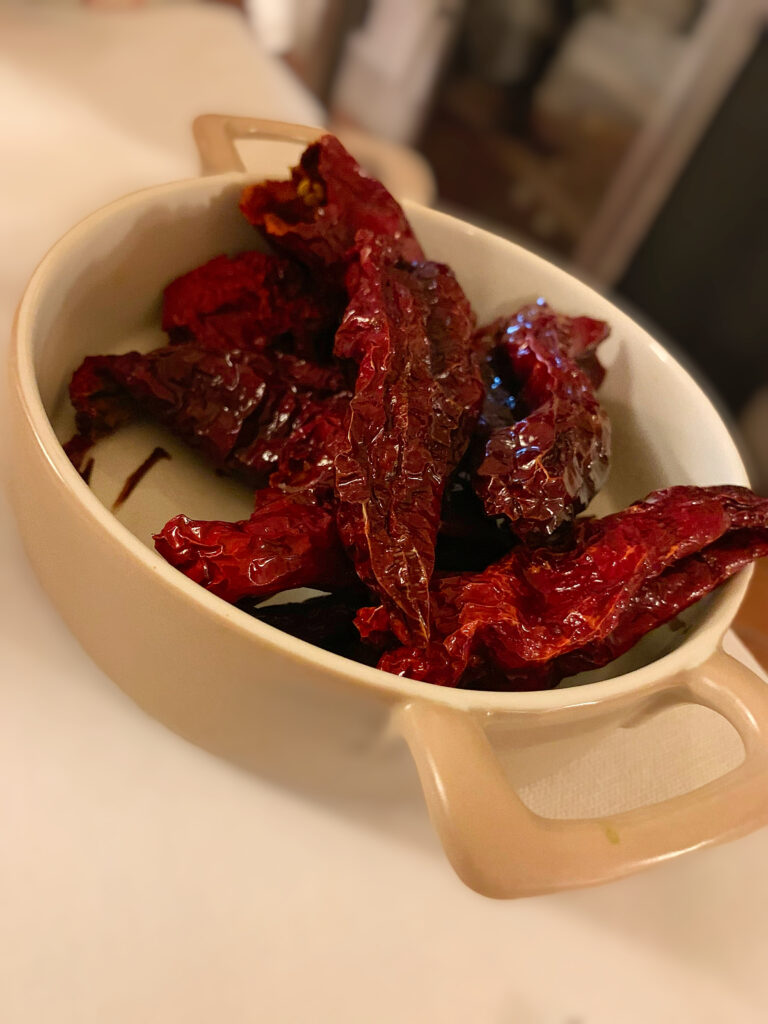
Crapiata
Between a soup and stew of legumes and cereals. It can be a little bland, so be sure to order some cruschi to sprinkle on top. The festival of Crapiata falls on the first of August and is still held today in some neighborhoods of the Sassi.
Peperoni Cruschi
Sun-dried peppers that are fried and served as a snack or used to add flavor to dishes. These are not chilli hot, but have a deep, warm summer taste. Good enough to snack on their own as an aperitivo.
In conclusion, Matera’s transformation from a place of shame to a pride of Italy is nothing short of remarkable. Visitors to the city can now explore its unique history, sample its traditional cuisine, and marvel at its stunning architecture. Whether you’re a history buff, a foodie, or simply looking to soak up the beauty of southern Italy, Matera is a destination that will leave you enchanted and inspired.
Getting to Matera
Matera is easily accessible from Bari, only 60km away. Travelers can take a train or bus from Bari to Matera, with both options offering stunning views of the Italian countryside along the way. The journey takes approximately two hours by train (with a change at Altamura). Sometimes the bus can be faster. here are connections direct from Bari airport or from Bari Centrale station.
Matera Centrale is the main train station. It is very central, and an easy walk of just over 5 minutes to Piazza Vittorio Veneto. It’s a modern, efficient train station.
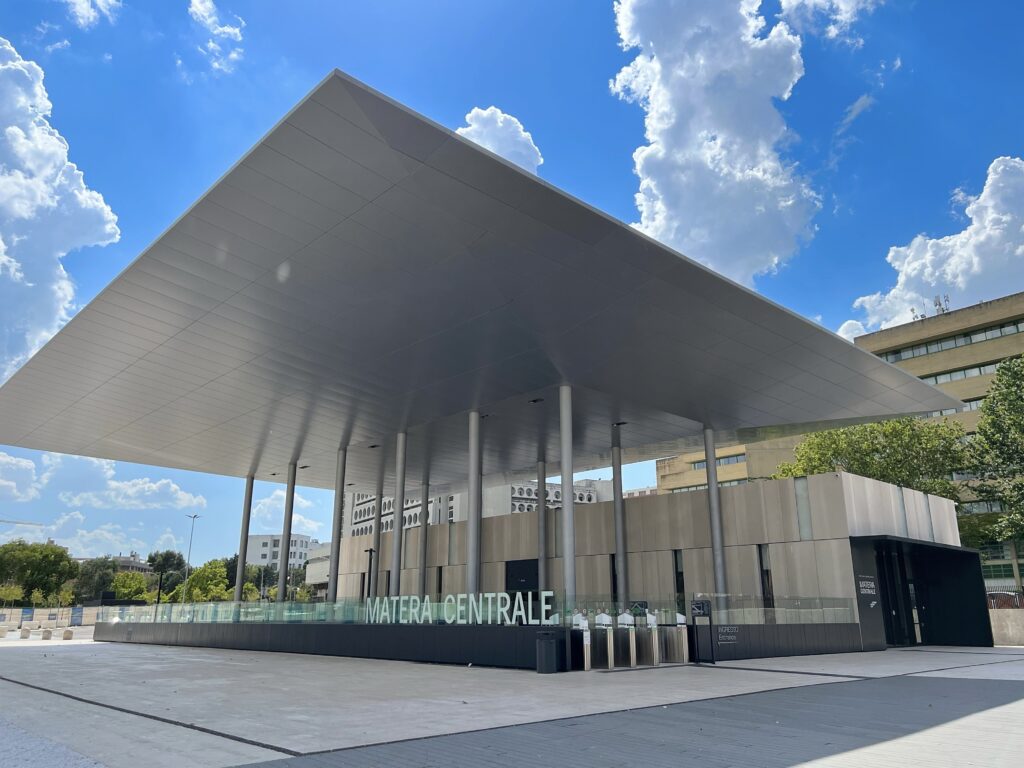
By road the journey from Bari to Matera is even more straightforward (and quicker). It takes just over 45 minutes by car from Bari airport and just under an hour from central Bari along the SS96, good dual carriageway all the way until you are almost in Matera. If you are coming from the south of Bari you will take exit 7B on the SS16 Bari circular to Modugno and after 5km take the SS96 ramp on the right lane for Altamura/Matera.
Coming at Matera from further south there are more scenic (but longer) cross country routes, via Gioia del Colle for example. If you get stuck behind a truck or slow traffic, overtaking might not be easy. Be prepared for frustration, and unforgiving Italian drivers behind you!!!
From Lecce via Brindisi and Taranto the journey will take just around two and a quarter hours. An hour less from Taranto. The majority of that journey is dual carriageway except for the stretches between Taranto and the toll road to Matera, and when you come off the toll road until Matera. Expect the same overtaking frustrations!
Where we stayed
Matera is on our doorstep and we can easily plan a day trip. But on occasion we have stayed over.
Matera Pride
Being one of Europe’s two Capitals of Culture in 2019 really worked for Matera. We noticed a big difference in how the city held itself out. Not only did it feel a much more sophisticated travel destination in summer 2019 than it had in the months before taking on the honour, it also felt more confident; with a real belief in itself.
 Matera is one of the highlights our Pride calendar. The parade took us into the heart of Matera and we took Matera to our hearts.
Matera is one of the highlights our Pride calendar. The parade took us into the heart of Matera and we took Matera to our hearts.
We went to support Matera’s first LGBTQ+ Pride in 2019. It felt as if the whole city had come out to wave their rainbow flags and cheer the parade on. A concrete example of the confidence and pride that the residents of Matera have developed in their city, its people and their communities.
Covid meant Matera Pride didn’t return until 2022. It didn’t disappoint with one of the better post parade celebrations.
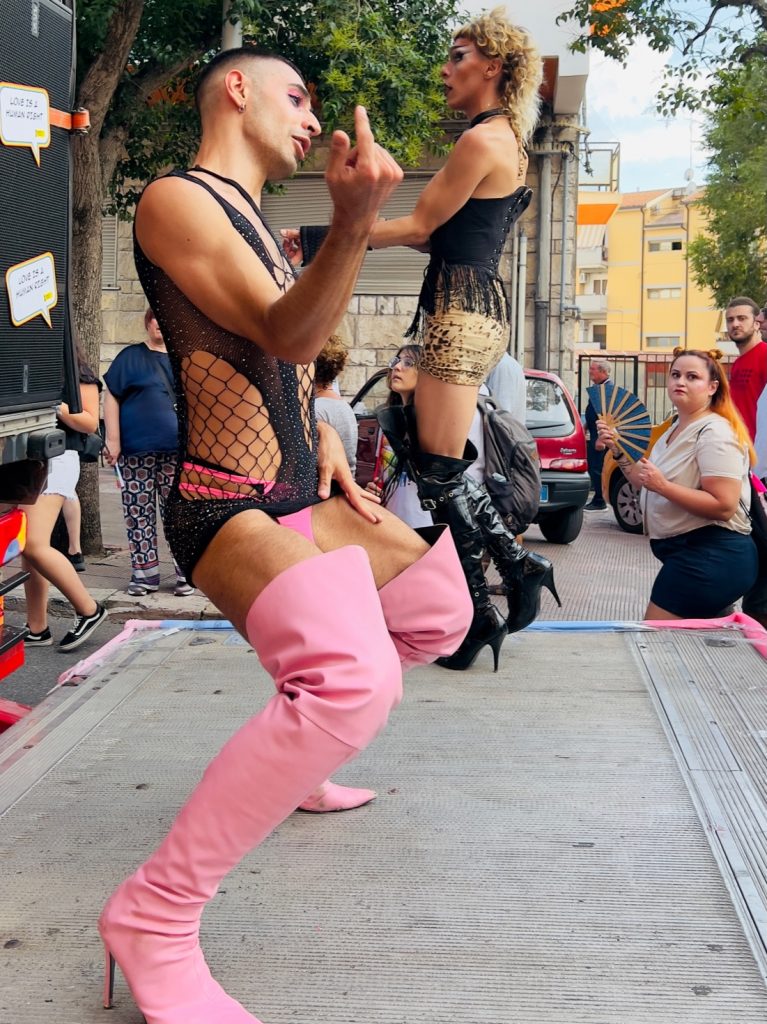

Matera Pride returns on Saturday 22 July 2023.
Visit responsibly | sustainable travel suggestions
Matera is a city that truly has something for everyone. Its rich history, stunning natural beauty, and vibrant cultural scene make it a destination that should not be missed. Whether you’re a history buff, a film fan, or simply looking to soak up the beauty of Italy’s southern region, Matera is a city that will leave you captivated and inspired.
As a tourist hotspot and cultural hub (cruise ships that stop in Bari and Taranto increasingly offer day trips), it is important to promote sustainable tourism practices to prevent over-tourism and minimize the negative impact on the environment and local communities. Here are some suggestions for visiting and enjoying Matera sustainably:
- Visit during the off-season: Consider visiting Matera during the off-season, which is typically from October to April, to avoid the peak tourist season. This will not only help reduce the impact of over-tourism but also provide an opportunity to experience Matera in a more relaxed and authentic way.
- Choose eco-friendly accommodation: Look for eco-friendly accommodation options that promote sustainable tourism practices, such as hotels that use renewable energy sources, have a recycling program, or promote local and organic food.
- Use public transportation to get there. You won’t need a car to explore Matera. This will help reduce the number of cars on the road and minimize the negative impact on the environment.
- Support local businesses: Choose to eat at local restaurants and shop at local stores to support the local economy and minimize the environmental impact of importing goods.
- Respect the local culture and traditions: Be mindful of the local culture and traditions, such as dress codes and religious practices, and be respectful of the local community’s way of life.
- Choose sustainable tours: Select tours that prioritize sustainable tourism practices, such as walking tours or bike tours, to reduce the negative impact of transportation on the environment.
- Avoid littering: Always dispose of your trash in designated bins and avoid littering to help keep Matera clean and reduce the negative impact on the environment.
By practicing sustainable tourism, visitors can enjoy Matera’s unique cultural heritage while minimizing their impact on the environment and local communities.
